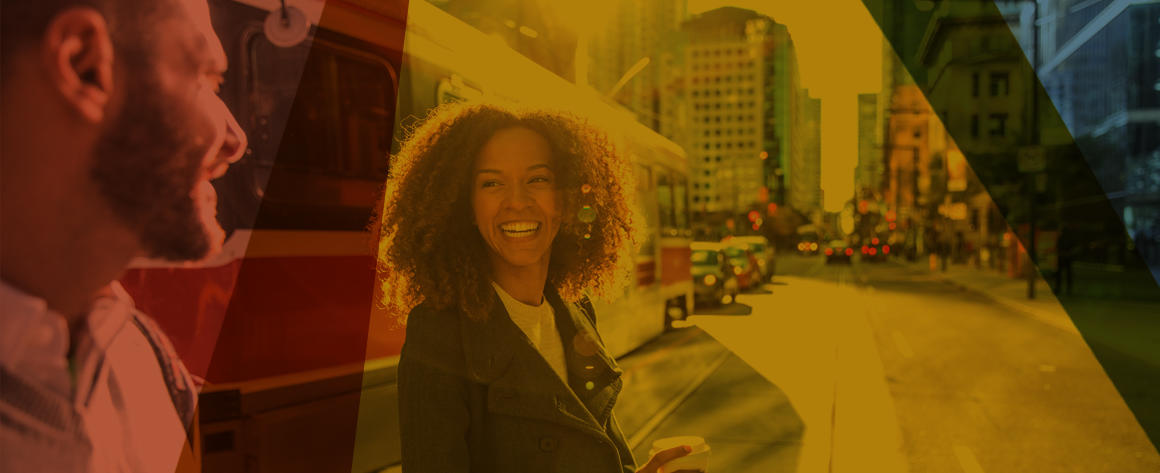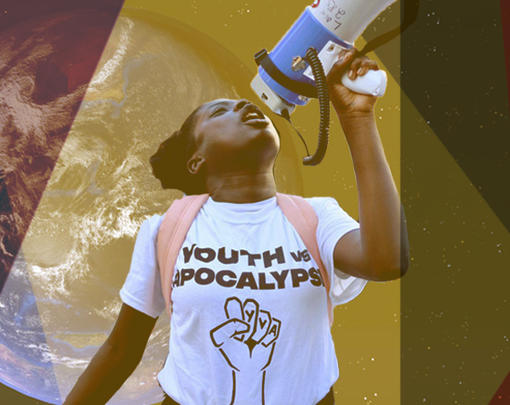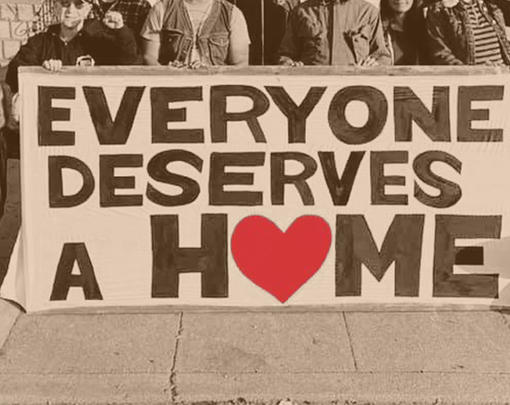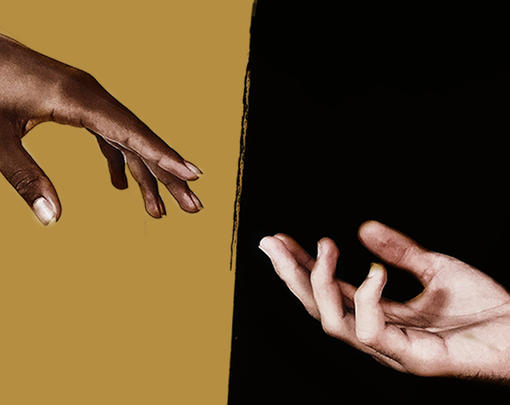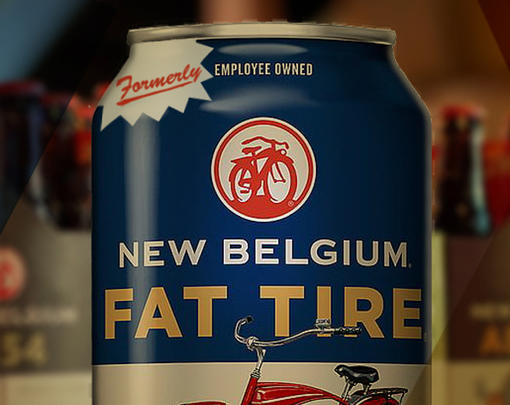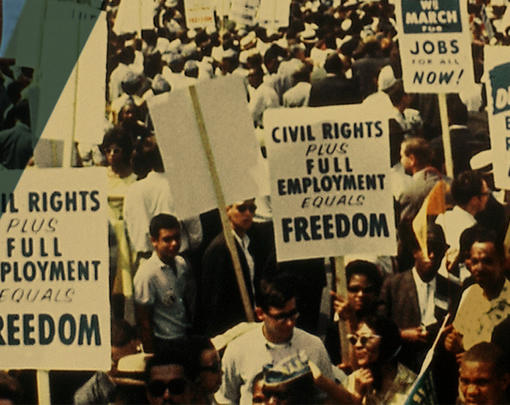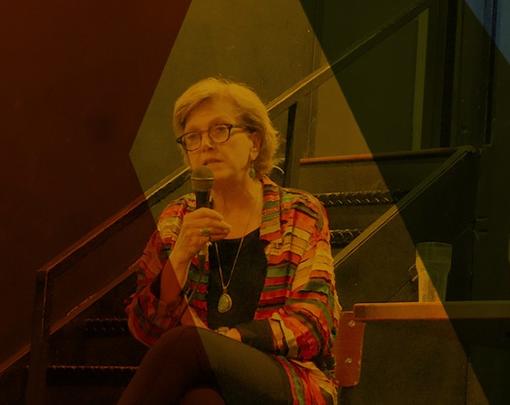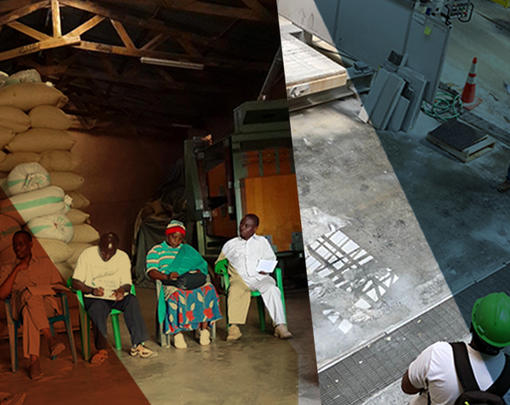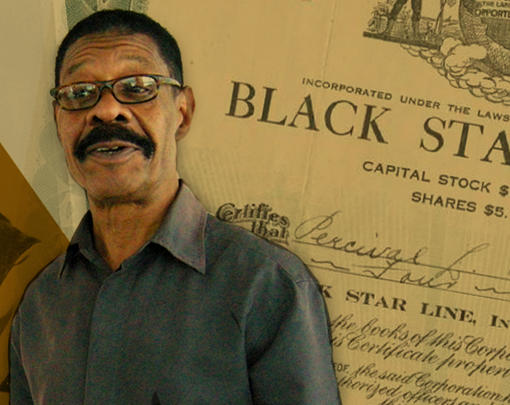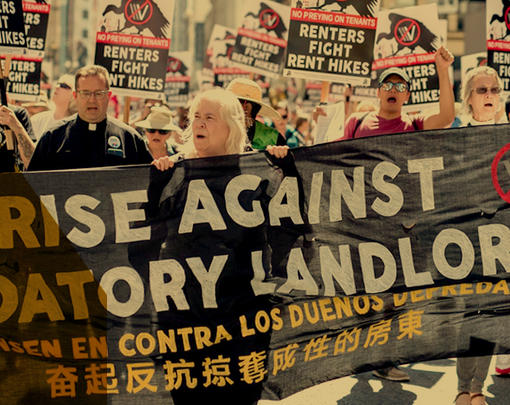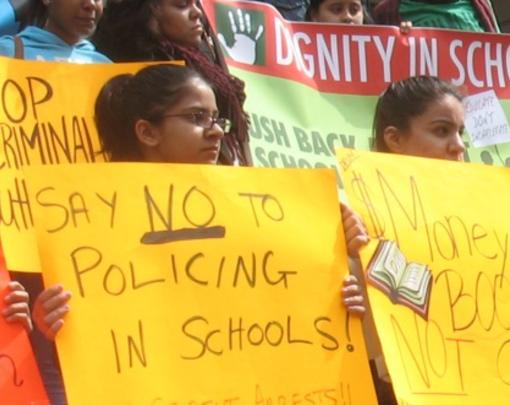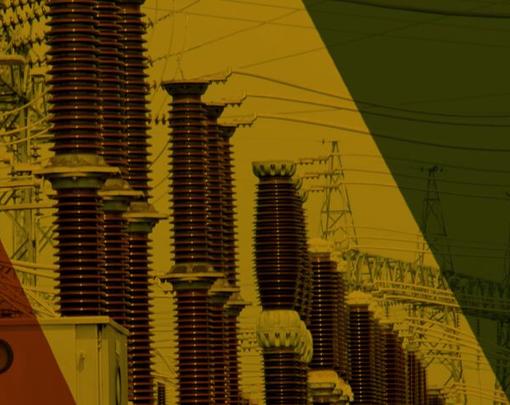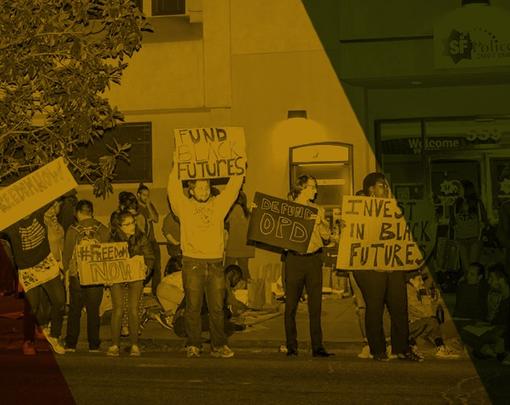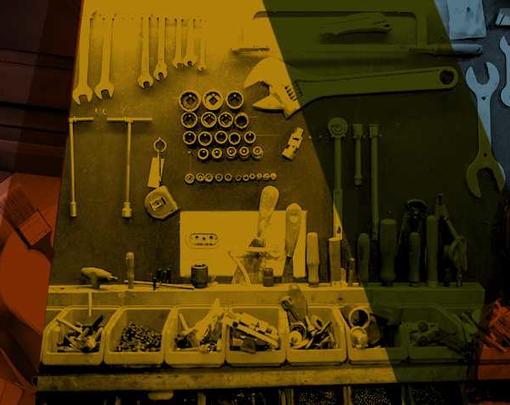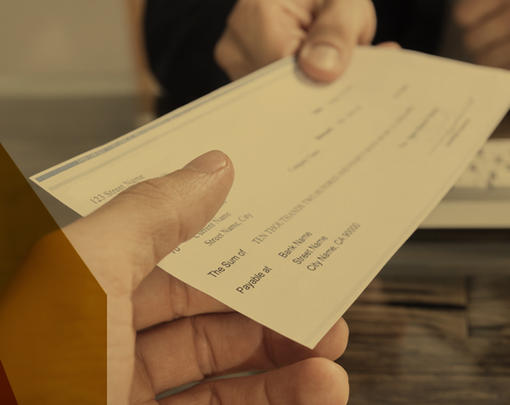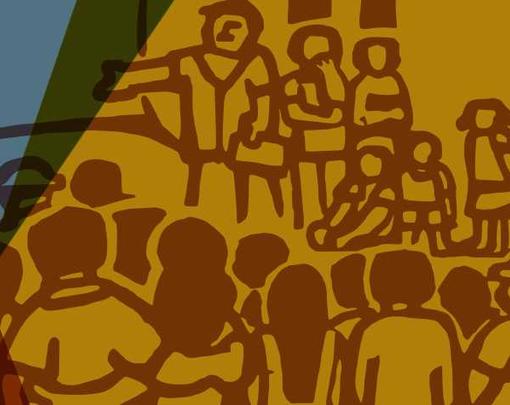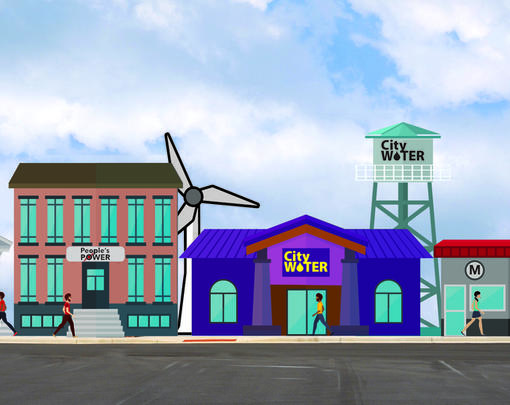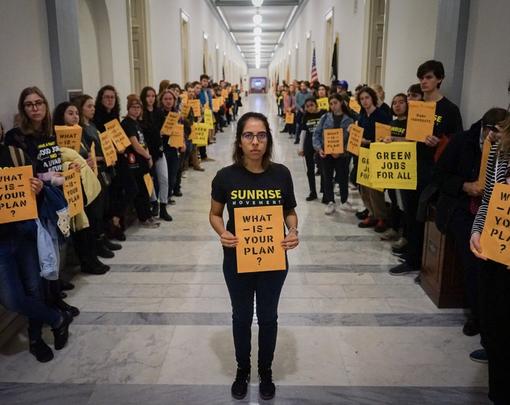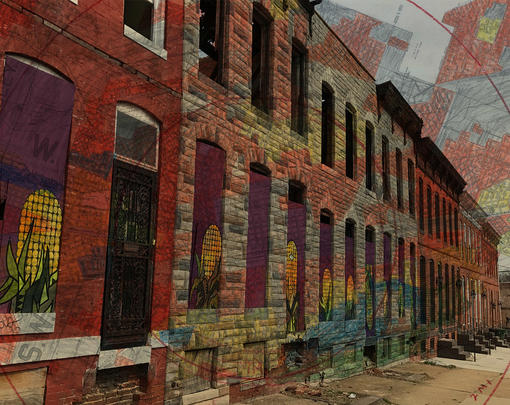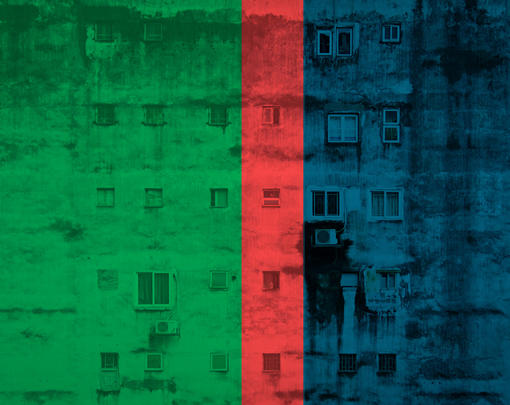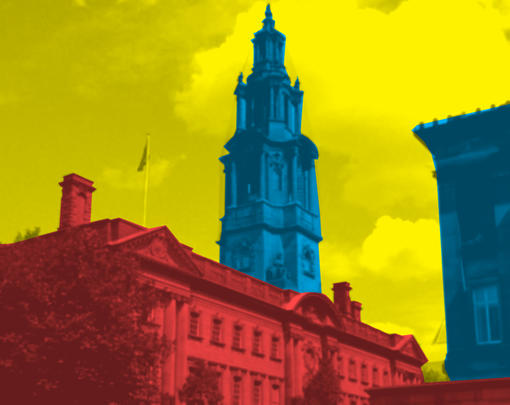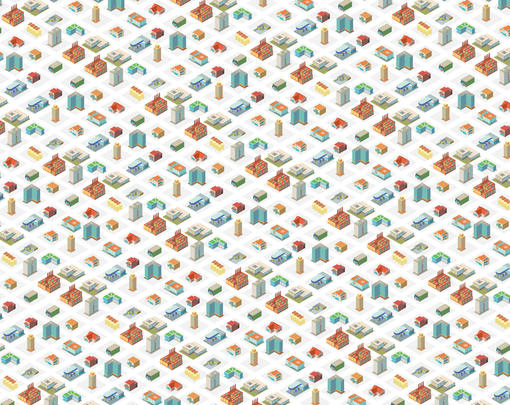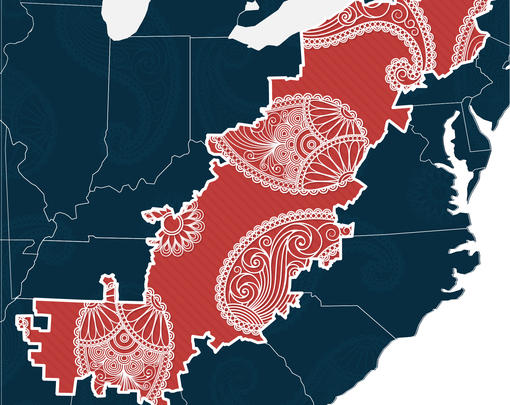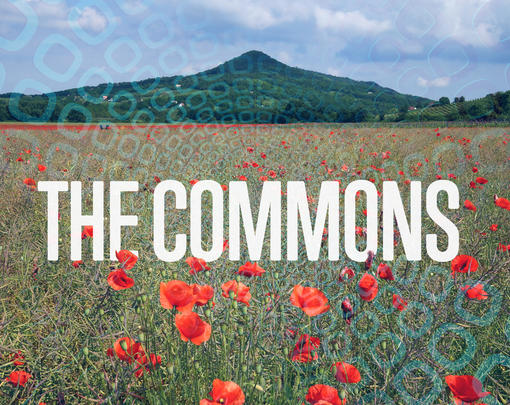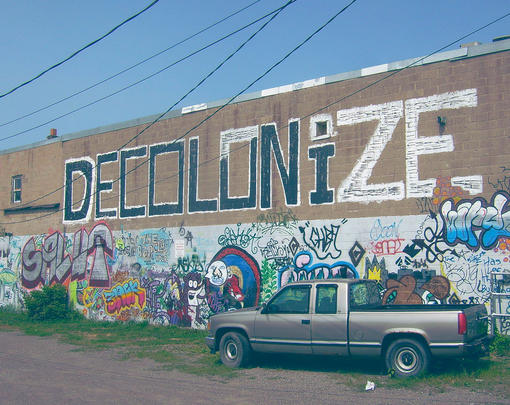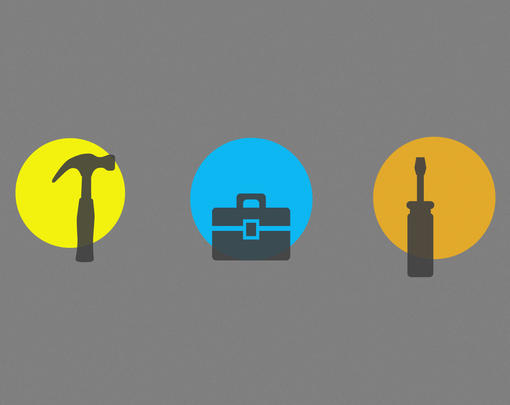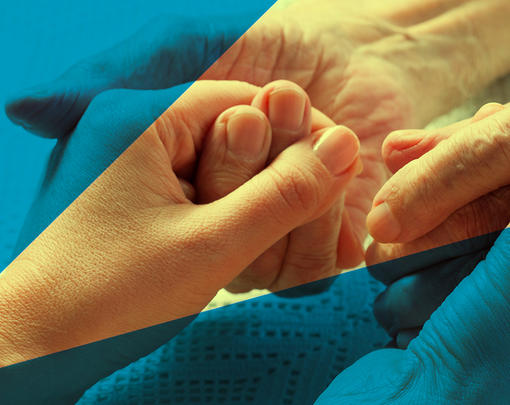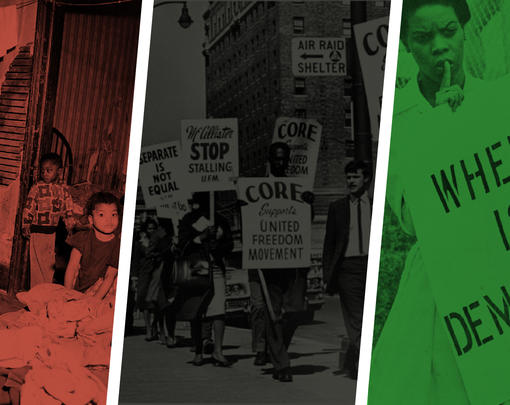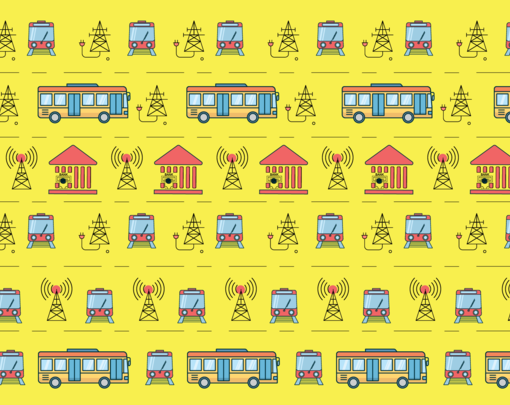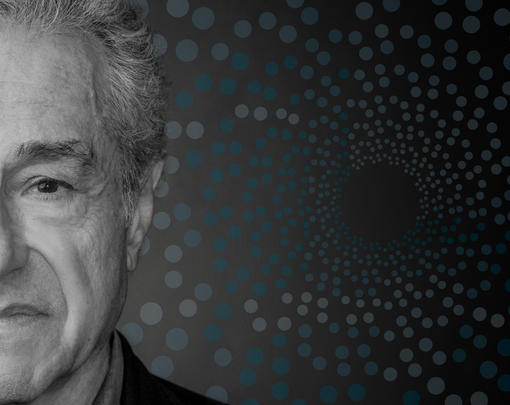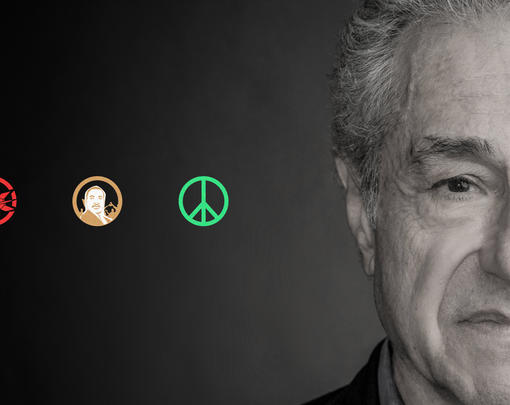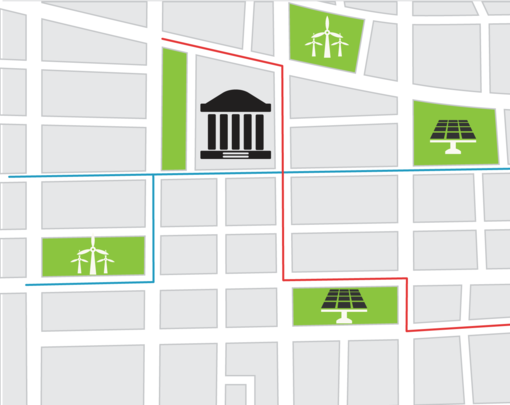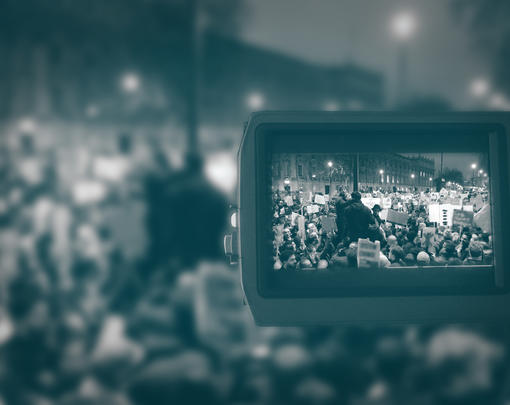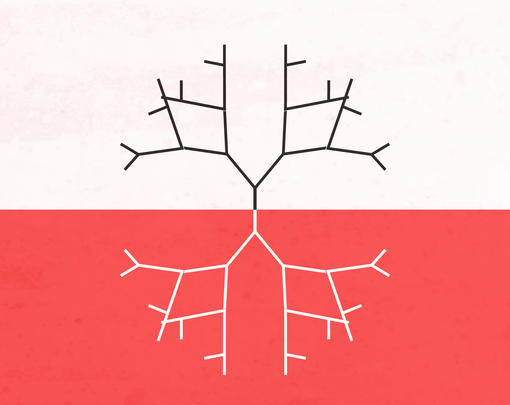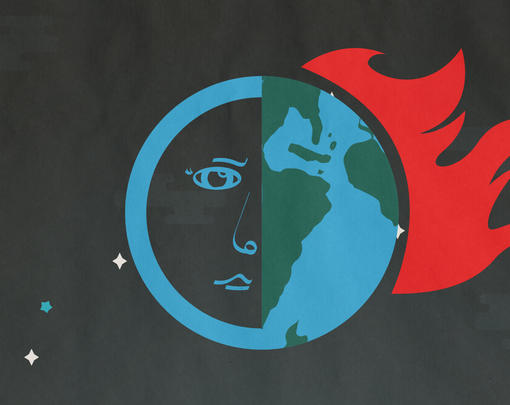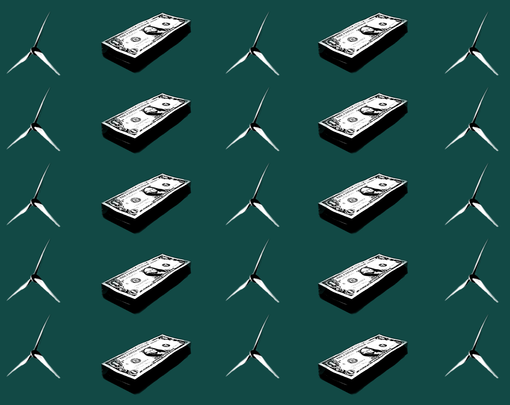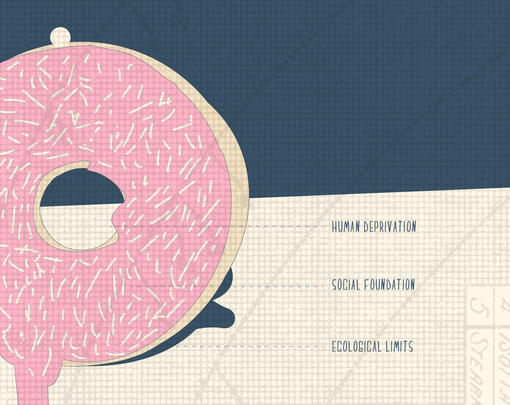This week we are discussing how to design communities for justice, in particular as communities seek to respond to challenges of climate change, with new projects from transit to infrastructure. Isaiah J. Poole hosts a panel featuring The Next System Project’s Johanna Bozuwa, the Institute for Policy Study’s Basav Sen, and We Act for Environmental Justice’s Michael Velarde.
The Next System Podcast is available on iTunes, Soundcloud, Google Play, Stitcher Radio, Tune-In, and Spotify. You can also subscribe independently to our RSS feed here.
Isaiah J. Poole: This is Isaiah J. Poole, and welcome to The Next System Podcast.
Today we’re talking about designing our communities for justice. There have been issues of gentrification and displacement that have risen to the top of community concerns in cities around the country. As cities experience an economic renewal, we’re finding that renewal is hurting rather than helping millions of people who are affected by such consequences as being unable to afford to continue to live with the communities that are being revived—which raises a question: What if development decisions were made based on a commitment to their social impact, shared prosperity, and community voice rather than narrow outside interests?
I have three people here who are going to grapple with those questions.
With us today is Michael Velarde, who’s the director of special projects at WE ACT for Environmental Justice. He is a Chicano organizer, writer, and strategist from El Paso, Texas. Before he joined WE ACT for Environmental Justice, Michael was a community and labor organizer in housing, healthcare, police accountability, and immigrant rights campaigns.
Johanna Bozuwa is a research associate here at the Democracy Collaborative. Her focus is on climate and energy. And most recently, she was the author of a report, “Building Resiliency through Green Infrastructure: A Community Wealth Building Approach.” Her argument in that report is that building climate resiliency, the things that we need to do to protect our communities against the effects of climate change, can be done with an approach that lifts up marginalized communities and communities of color.
Finally, we have Basav Sen, who is the climate justice project director at the Institute for Policy Studies. His work focuses on climate solutions at the national, state and local level that address racial, economic, gender, and other forms of inequality. Thank you all for joining us.
Johanna Bozuwa: Thank you so much, Isaiah.
Michael Velarde: Thank you.
Isaiah J. Poole: So I want to start with something that I find very interesting that’s happening in East Harlem, in New York. WE ACT for Environmental Justice recently led a process around a community vision for East Harlem’s future that is directly connected to the construction of the Second Avenue subway line in New York City. As I understand, it’s the first new subway line construction, other than the Number 7 extension going west from Grand Central Station, in many, many decades. But Michael, tell us about the context for this community vision for East Harlem, and why it’s important.
Michael Velarde: Thank you, Isaiah, for having me on the podcast. One thing that you triggered as you were talking now is this idea that the subway, the Second Avenue subway, is a rarity in terms of new subway construction in the city. I do this amazingly long PowerPoint presentation that has a slide in it of Halley’s Comet. You can see the last time it came around was 1910 and then 1986. And so you have a better chance of seeing Halley’s Comet go by in your lifetime than you do seeing a new subway get constructed in New York City.
The original idea for a Second Avenue subway was proposed in the 1900s. And they’re expected to finish this second phase of it by 2027, 2029. So it’s really a once in a lifetime opportunity that we think really merits strong, robust community leadership around.
And so the context for the project really was, in 2017 we understood that the Second Avenue subway was coming to East Harlem, and that after the rezoning that took place in the neighborhood that there would be a massive incentive to redevelop and to really bring in new developments to the area. And so specifically on 125th Street, the impetus was there for massive development construction that really didn’t take into consideration or wouldn’t take into consideration community needs and desires.
Isaiah J. Poole: So one of the things that I noticed in the report is that there was a real concern about the fact that there were buildings that were being left vacant, and there were stories about people, renters being in the process of being pushed out of that neighborhood in anticipation of this subway line opening up opportunities for developers to come in and rebuild these communities and push people out.
Michael Velarde: Yeah. So I think one just piece of historical context is that 125th Street in Harlem is a major thoroughfare. It’s not very long. It’s about a little over a mile. But throughout the development of particularly Black Harlem, 125th Street has been critical. I mean, it’s a site of commercial, political, religious, social movement activity for generations. Any major figure in the black freedom struggle has made an appearance along 125th Street. And so it’s this core artery for northern Manhattan that hasn’t gotten developed evenly. So what I mean by that is, if you walk from the western section of 125th Street to the east section, which is what we’re talking about in our report, you notice that the west and central portions of 125th Street have already been developed due to previous rezonings and what many have called gentrification plans, which there’s a Red Lobster there, there’s Abercrombie, there’s big-box retail developments there.
Isaiah J. Poole: It’s a very different 125th Street from what it was not only from the Harlem Renaissance era, but even the 1970s, 1980s.
Michael Velarde: Absolutely. And so if you walk over just past 5th Avenue, you notice that the east side is starkly different than that. So regardless of your opinion on what these big box outlets, whether they’re good or bad for the neighborhood, you can see very clearly that the amount of attention and political interests to those sections of 125th Street have played out much differently. And there’s been much more of that there and much more resources. On the east side you’ve seen a number of unfortunate political, and design decisions that have under-resourced the area that have concentrated a number of social services, a number of sanitation depots. East Harlem carries three sanitation depots in its district when, in the city, each district is only supposed to carry one. One way to think about it is that East Harlem subsidizes other parts of northern Manhattan and the city through carrying these sort of undesirable elements. So they’re carrying sanitation, they’re carrying drug treatment programs that the elites look down on. And so you have this situation in which there’s a lot of distress and deliberate under-resourcing of the neighborhood. And so the context for displacement has been historically building up for the past two, three decades. at least.
Isaiah J. Poole: I want to get into this concept of community-centered development. But before I do that, I want to bring Basav into the conversation. And I’m wondering from a national perspective, how does this fit into what you see around the country?
Basav Sen: It fits very well with a pattern of what I would call sacrifice zones, where certain communities, overwhelmingly communities of color, poor communities are made to pay the price for our industrial system and our entire economy, whether it’s communities next to polluting power plants, or communities in extraction zones. And extraction zones are in a double bind because not only are they dealing with the pollution impacts, but they’ve become dependent on extractive industries for employment opportunities. And their economy remains undiversified, which is a lot of what you’re seeing in Appalachia, for example. And which is why there’s often pushback to the notion of trying to cut back on extraction and move away from fossil fuels. And honestly, you can’t blame people who’ve repeatedly been marginalized and not allowed to develop their local economy in a way that benefits them as against distant elites.
And you see that replicated in local communities as well with gentrification and with how communities that have been neglected for a long time, and polluted, and under-resourced, and lacking in employment opportunities, transportation facilities, etc. Suddenly those communities, when they catch the attention of real estate developers, they get investment; they get new transportation facilities and employment opportunities, etc., except they are never intended for the benefit of the people already living there who are disproportionately people of color and poor people. It’s like all this new investment is for an influx of new people who are wealthier. And that’s the process of gentrification that is playing out in cities across the country. So very much what we heard about struggles in Harlem is relevant to what you see everywhere.
Isaiah J. Poole: Johanna, one of the things that struck me reading your report, “Building Resiliency through Green Infrastructure”—which by the way, listeners, if you’re interested in the report that’s at democracycollaborative.org/green infrastructure—was that even as grassroots enterprises are working with green infrastructure, and they are hiring people in the community to do green infrastructure work, there is this fear that the work that they are doing to improve their communities will eventually be work that they will not be able to benefit from.
Johanna Bozuwa: I think that’s a really good point, and something that was articulated by many of the people I spoke to who are on the ground working on kind of climate resiliency strategies. One of the things that I was really excited about in having this conversation today with Michael and Basav was that particularly this vision of East Harlem and this concept of community-centered development can really shift. I like thinking about this from a very complex systems approach, taking the opportunity of this transit hub to really think about what development or community design looks like in a specific locality, and how you actually ensure that it’s about recentering development. And Michael, I’d be really interested to hear kind of how you see this, and how you define community-centered development. But for me it means reshifting our perspective on development so that it’s not about bringing people in per se, richer people to develop the area, but it’s actually about providing new spaces for folks who actually already live there and opportunities.
For instance, through green infrastructure we are talking a lot about how we create a city that is resilient to climate change. And climate vulnerability is deeply tied to political and economic disenfranchisement. And so how do we actually get at those things through our design of these new communities? And I think that is why in the report, I put a big focus on the relationship between implementing green infrastructure and affordable housing, because a major problem for these grassroots or community wealth building enterprises was that they don’t want to implement green infrastructure and create a more resilient space, and then have that as a catalyst for additional gentrification.
And so how we actually need to think in the systems approach like folks at the environmental justice are doing to kind of think, okay, if we’re going to implement climate resilient strategies, and we’re going to employ local folks, they also have to ensure that people can continue to live there by integrating that with long term affordable housing plans that are for the folks who had been there for a while. But yeah, we would love to hear from Michael and Basav around … we’ve talked a lot about what extraction can look like in these areas, but what is the alternative in a lot of ways?
Isaiah J. Poole: So Michael, go ahead. What is, in your mind, community center development, and how is it working in East Harlem?
Michael Velarde: I think one way to think about it is, the big threat here along 125th Street is that through the Second Avenue subway, through the 2017 rezoning, and actually through the opportunities zones from the tax cut program that President Trump signed in 2017, you really have a situation in which these market and political forces are incentivizing a low-road development model that focuses exclusively on profit, right? And so what we’ve attempted to do in the past two years is uplift an alternative model that puts people at the center of development decisions in a way that can leverage the new change that’s coming, in a way that benefits local needs and local desires. Because one of the things that you don’t think about in development conversations, particularly in low-income communities of color, is that there’s a tremendous amount of assets that these communities have.
So in East Harlem’s 125th Street corridor alone, you have amazing transportation connectivity. It’s already servicing a number of trains, subway lines, etc. You have an amazing cultural identity that’s diverse and multiethnic, not just the Puerto Rican image that you think about when you think about el barrio, but increasingly immigrants from west Africa and other countries. You also have this rich tradition of community organizing mutual support and entrepreneurship that should be a part of any development conversation anywhere. Right? And so I think part of what we attempted to do through this process is actually activate those assets so that people can benefit and address some of the entrenched racial, environmental, and public health inequities that folks are experiencing throughout the neighborhood, but particularly in this strip of it, and to also be able to uplift a different vision.
One of the issues that folks have faced in East Harlem in particular, but I’m sure this is applicable to any low-income community of color across the country, is this idea that there have been a hundred different development projects that have been proposed either by the city or private developers that have actually not really gotten off the ground. And part of the reason that we’re saying that this issue is so critical right now is that, the infrastructure piece of it, the new subway transit access that will be opened up over the next 10 years, is actually a certain thing that’s going to structurally reconfigure the market..
So you mentioned Isaiah, in the beginning, this notion that we had pointed to in our report that about 25% of the storefronts on 125th Street have been held vacant by property owners. And that’s much larger than any other place in the city that I’ve seen. I think it’s somewhere between 10, 15, maybe sometimes 20 percent in other areas of the city, but a stark 25%. And so you have to ask the question, why are people holding on to these properties? And they’ve kind of laid it out very clearly: They said they’re waiting for the market, “they” being developers and real estate operatives. They want to see the market change so that it’s more lucrative for them and their interests.
And so what we’re doing through this process as Johanna was mentioning is, this is a systems approach. We had to see the whole idea of development from a multifaceted sort of lens. And so people wanted to talk about in the same conversation as economic development, talk about arts and culture, talk about transit, talk about vibrant public spaces, talk about community-owned businesses, or local enterprises that can actually meet community needs. And so I would say that these are some of the defining features of a community-centered development model which seized the opportunities, I think, in a more robust way, then sort of a narrow profit bottom line.
Isaiah J. Poole: What I’m having trouble visualizing is, what exactly makes this process look and feel differently from, say, the traditional city government planning meetings or zoning meetings, which sometimes are just centered around one thing, but can be broader to the neighborhood level? What was it that makes your effort in East Harlem unique?
Michael Velarde: Well, first and foremost, this is a community-initiated process. And so the feel of it is much different. When you’re actually creating the framework, the ideas, the priorities within all of the participatory exercises that you go through, when it’s led by people who are either residents, own small businesses or have worked in the area through local nonprofits or agencies, they have a different kind of commitment to the fate or future of the neighborhood. And I think when you start off the process with that premise that community voice will be heard, will not only come out in the form of input, but we’ll actually develop and design some of these parameters for development. You have a conversation that’s more grounded in community needs, and is probably more inspiring to people than going to your typical kind of city planning meeting. Those aren’t known to be ragers, but coming together in the neighborhood and having these conversations and saying, listen, this is an opportunity for people to actually shape the future of the neighborhood, is much different than some of these other city processes. Typically, those about validating a particular idea, and for us we were actually in the business of creating and sourcing ideas from the perspective of the community.
Basav Sen: I was just going to add to that. That is why deepening democracy is so critical, because a lot of these official planning processes, they’re almost like checking a box. They have a rule somewhere that they need to consult the community. And so they have this meeting, which is structured as a one-way presentation, which exactly like Michael said, is to advance this one vision. And people come and say what they want, which could even be very critical of that vision. But as far as the city planners are concerned, they’ve checked the box that they’ve held this public hearing, and then they go ahead and do whatever they want. Which is profoundly different from a bottom up process where decisions are actually made by the affected people, which is exactly what this effort in East Harlem seems to be getting at.
And that’s what you need at all levels, from the local to the national processes where the affected people, the people who are dealing with the consequences actually get to shape the policies to address it. And I’ll give you a stark example of the opposite. So here in Washington DC, our public transit system, Metro, has been not operating at night for several years now because of much-needed safety repairs. But now the repairs are almost done, and they have the opportunity to restart late-night service soon. It appears they’re not going to do that. And instead they’re going to subsidize low-income workers to ride Uber and Lyft instead of restoring transit service. And that’s profoundly unjust on so many levels.
First of all, the subsidy is only $3 per ride, which is not really going to defray the costs in a meaningful way for low-income workers. Number two, you need to register to get the benefits, which will automatically exclude a lot of undocumented immigrants who are afraid of registering with any official body. Number three, it’s going to exacerbate climate change and pollution because you’ll have more single-occupancy vehicles operating instead of transit. Then there’s effects on congestion, effects on safety. I could go on and on.
But anyway, getting to the precise point I was going to make, a coalition of groups, national and local groups sent a letter to Metro saying that this is a bad policy, and you need to reconsider. And Metro’s reply was, thank you for your input, but we’ll go ahead and do what we want to do anyway. And the fact that Metro was not even required to seek public comment or hold a public hearing, and could make a decision as profound that affected that many people just as an executive decision by the board, that just goes to show how profoundly undemocratic a lot of our decision-making structures are even in a country that claims to be a free country, and a democracy, and all of that. And so the solution or at least one of the key solutions to a lot of these problems is actually open up decisions to genuine popular grassroots democracy. And that will start to shift decisions in a way where affected communities actually make policy to their benefit.
Isaiah J. Poole: so, Johanna: You put your finger, Basav, on the question of how you actually connect community-centered development to something that actually makes public opinion matter. Johanna, how do you think then, when we talk about things like the Green New Deal, for example, which would create a significant shift in the energy economy of the country, what do you need to do to make sure that public voice is at the forefront of that kind of transition?
Johanna Bozuwa: So I think that this is something when it comes to the Green New Deal, because it’s being talked about at this federal level, if we get something like this passed, hopefully, that will mean a potential huge influx in redesigning our cities and our communities and rural areas so that they reflect the resiliency we’re looking for. And I think it’s going to be a challenge in terms of ensuring that that doesn’t get co-opted by specific developers or specific companies. For instance, I think that the example that Basav gives around the Lyft taking over what should be a public good for private gain is something that we’re going to have to be really, really clear about when it comes to things like the green new deal to ensure that that doesn’t happen as we’re redesigning cities.
I think what we need to do is look to examples like what WE ACT for Environmental Justice and Michael have done in terms of what’s working in terms of engaging folks. How do we create grassroots-based action plans for climate that actually are taken seriously by the powers that be, and how do we just actually flip that concept of power so that it is at the grassroots planning? And it’s communities planning their communities instead of developers coming in, taking that money and redesigning it for themselves, with the potential to turn certain areas of our cities into ecological enclaves instead of actually distributing that benefit.
I think this is another place where I see intersection in terms of who is actually delivering the service, in terms of who is actually doing the work. If we have community-based enterprise or community wealth-building enterprises that are actually helping to build this too, I would also hope that that would provide additional agency, because workers who live in their communities often know what’s going to work better for that community. So I think that even when it comes to it, there’s the development phase, but there’s also the phase of implementation, and how we do that in a just and equitable way. But Michael, I’d also be really interested to hear some of the outcomes and lessons learned from this community-centered development process that you think we could apply in other communities as well in the future.
Michael Velarde: Yeah, definitely many lessons learned throughout the nearly two years that we’ve been engaged in this process. I think, one of the key pieces of it is you have to take your time. You have to be able to engage in meaningful consultation with community members and other stakeholders. And the reason I say other stakeholders is because we also wanted to create space for not just residents or tenants who work at the center of this project, but also other stakeholders who are impacted by these development projects now and moving forward.
So the transit users, we conducted a survey to try to understand their needs and desires. We talked to small business owners. We built a coalition of over 40 local community organizations working on a range of issues, from homelessness and drug dependency issues—we had an amazing partner in Picture the Homeless—to other social service and small business developers, like a union settlement here in East Harlem. And so it was really critical to also build that coalition out, especially early on, to be able to overcome some of the political challenges that exist in East Harlem, and I think in other similarly situated communities.
Part of what I mean by that is, as I mentioned earlier, development, redevelopment, revitalization, anti-blight measures—there’s a whole history of city and private-led sort of approaches to development that I actually think mirror redevelopment or development efforts in the global south. I mean, there’s this notion that there are unproductive spaces that for different reasons should be transformed into spaces that make money.
And I think that’s left obviously a lot of bad blood in the water for local communities who have had to live through different iterations of development and revitalization, and they’ve not ever seen any benefits to it. I think the big piece there is that, as you were saying, it’s about power and decision-making ability. And for the environmental justice movement, one of the core principles particularly for WE ACT is to be able to create the conditions in which local people can make decisions for themselves, and can shape particularly the policy decisions that impact their health and wellbeing on a day-to-day basis.
So one of the lessons, moving from that piece is that there are going to be conversations in which folks will be on different sides of a particular issue. One of the big issues along 125th Street is homelessness. And that’s partly by design. The city and state have concentrated a number of shelters and other social service providers in the area. And so you have a larger population of homeless people there. And so one of the things that we knew from the beginning was to have actual homeless voices in the room to be able to articulate their perspective and their needs and the solutions that they see on the front lines every day. And so that didn’t sit well with some of the other folks who perhaps from the small business community, or folks who I think want to redevelop the area for housing purposes or other retail purposes, well, that’s a hot-button issue.
And so one of the things that we had to do from early on is say, listen, in this space, we respect everybody’s right to be present and to have a voice in this process. And so we’re not going to demonize homeless people. Right? And so we had leadership from Picture the Homeless, as I’d mentioned, their members turn out and participate actually in some of these design sessions from day one. And so that really when you have to center that you can say one of the things is, we may not always agree on all of the solutions, but we can begin to create points of unity so that we can structure the conversation in an equitable and just way.
And so one of the things that I’m quite proud of is that through this process we actually kept residents, and particularly the folks who were the employees of the other nonprofits that work in the area, together for almost two years. And so this may not seem like a big deal, but when you have people sitting down and having similar conversations for the past decade, it begins to become a bit dry. And so one of the things that we had to do very consciously is really show the difference between this process and other processes around development or revitalization in the neighborhood historically.
Johanna Bozuwa: What strikes me Michael, as you’re speaking is this concept of sometimes we have to go slow to go fast in terms of building the relationships, keeping folks engaged over, it sounds like a two-year period, but I’m sure now that you’ve created this vibrant network that can be catalyzed in other forms as well as this development continues to go forward. And I think for me, that really stands out as a lesson in terms of how we’re building. We need to build these things from the ground up now. And that continues to build our power and our ability to intervene in these spaces in the future, too.
Basav Sen: A key lesson I feel like is that justice and equity are equally important goals as whatever else you’ve set for yourself, whether it’s job creation or addressing environmental impacts. Because if you don’t build it in from the beginning, if it becomes an afterthought that you design a policy and then think about how to address justice and equity impact, you’re always going to end up with an unjust outcome.
Isaiah J. Poole: So I’m thinking one of the things that will be coming down the pipeline, maybe not this year, maybe not in 2020, but possibly in 2021 is a major federal infrastructure bill. It could be a trillion dollars, could be as much as $2 trillion that House Speaker, Nancy Pelosi, and Senate Democratic Leader Chuck Schumer were talking about with President Trump recently. When that pot of money washes into communities, what would we like to see happen in terms of a process that makes sure that communities actually are well-served by those dollars? And for that matter, not just with a federal programs, but with some of the state and local planning that will be going on over the next decade. What would we like to see, and how do we get there?
Basav Sen: Let me rant for 30 seconds.
Isaiah J. Poole: Sure.
Basav Sen: There’s a fundamentally false narrative that even progressive’s keep voicing that, oh, our infrastructure is crumbling, our roads, and bridges, and sewers, etc., are crumbling, and they need to be rebuilt. What is false about it is imagining that there was some prior past pristine state that we need to go back to by rebuilding. And that doesn’t take into account that a lot of our infrastructure is, number one, unequal. Where certain areas were prioritized for infrastructure while others were neglected based on systematic inequalities of race and class. And number two, that because of climate change, we cannot rebuild infrastructure for yesterday’s standards. We have to build infrastructure, reimagine, and build infrastructure for future needs. So those false narratives from some of even our own allies, we do need to push back against. Sorry for this rant, but I just-
Isaiah J. Poole: Totally, I think that’s a very good point. Johanna and then Michael, I’m going to give you the last word, but Johanna first.
Johanna Bozuwa: I believe that what Basav said here is so key, is that, yes, there are parts of our infrastructure that are crumbling, but in many ways what we’ve seen is that our infrastructure was designed very specifically, historically to redline circling the communities, and that has been exacerbated over time as certain areas get brand new nice things and are developed or redeveloped for climate resiliency, but others have not. And that has continued to create the divide that we see within America and the United States. And so if we’re going to talk about an infrastructure bill, one, I think what Basav says around is just this disproportionate effect on specific communities needs to be considered, and it historically has not in infrastructure bills.
And two, the infrastructure bill that we need right now is absolutely not building new highways in the same way that we were doing historically. We are again, having to rethink how our communities operate, and how our economy operates so that it is one that is based on justice, based on the realities of climate change that has already been baked into our system due to pollution and extractive industries—and also how we stop further climate change, and how we stay under 1.5 degrees Celsius all through this infrastructure bill. And I think that we need to continue to push that and ensure that at the same time, the way that we actually can create that opportunity is in large part by thinking about how we create a more participatory process in the redesign.
Michael Velarde: I think, it’s absolutely important to complicate this idea of infrastructure as Basav and Johanna have done. In New York City, for example, in New York state more broadly you have the mayor and the governor—Mayor Bill de Blasio and Governor Andrew Cuomo—talking for years about doing infrastructure, right, and expanding the infrastructure in New York. So it’s not a new thing. I mean, infrastructure is an amazing political chip that folks can use because it’s seen as just unambiguously, unequivocally good, right. People don’t see a problem in building more infrastructure.
But to complicate that a little bit, I mean, as Basav was mentioning in the beginning, infrastructure is also not equitably distributed in terms of the investment, in terms of the resources, in terms of the political attention on issues. But your built environment is crucial to shaping a whole community’s life chances. So whether you have access to parks or efficient and effective public transit has a tremendous amount of different consequences for your life over time.
So one of the things that we’ve been stressing throughout this process is, infrastructure is actually, if done correctly, can have tremendous benefits for local residents. It doesn’t have to always just result in displacement. But one of the things that I just want to highlight here is that we’ve begun to talk about towards the beginning of the second phase of this project is transit access points. I mean, there’s a lot of research on this.
When you build new transit in communities, particularly low-income communities, the value of property rises dramatically—for commercial properties, at somewhere around 16%; for residential properties, it’s about 4%. And so what we’re saying through this process is that, if you’re going to enhance the value of properties that are in our communities, then we should begin to engage in strategies that actually can capture some of that value and reinvest it back not just into the infrastructure or into the transit construction components, but reinvest it back into community needs. And so that’s not been done. That’s a novel idea for New York. And it’s not really been done in much other parts of the country.
But what we’re saying is that, if you’re going to build in this area, let’s really think about how to dig our heels into this and make it work for the community because it is a tremendous opportunity. But if you follow the low-road development model you’re not going to get there. And so any new investment in infrastructure, we have to make sure that it gets to the communities that have been underserved historically and marginalized historically, and that it’s thought about in comprehensive and holistic ways that center community needs and desires. Because otherwise you’re just going to have, as you’re saying, a new bridge, a new road. That doesn’t necessarily create social value. Maybe it facilitates the movement of capital, but it doesn’t get to community needs.
For New York City, all you have to do is look a few miles north from Harlem, and you can talk about the historical experience of the Cross Bronx Expressway, which in the late 40s and to the early 70s is just this massive expressway construction that displaced local communities that was done without any input from the people who live in the Bronx, and has pushed traffic significantly through whole communities. So you have people breathing in all of this pollution and exhaust that has huge health impacts.
The infrastructure is key, especially if it’s done equitably and especially if the value that it can create is actually appreciated for what it is or what it could be and actually gets reinvested back into the communities who need it the most.
Isaiah J. Poole: This is a fight that we’re going to have to fight all over the country. And I want to thank all of you for bringing some key ideas about how we bring more democracy to this process, to the forefront. Michael Velarde, for those who are interested in WE ACT for Environmental Justice, go to weact.org. Basav Sen, at the Institute for Policy Studies; you will find his work at ips-dc.org. Johanna Bozuwa, her work is featured at thenextsystem.org. Thank you all for being on the program, and listeners, watch out for the next edition of The Next System Podcast.




